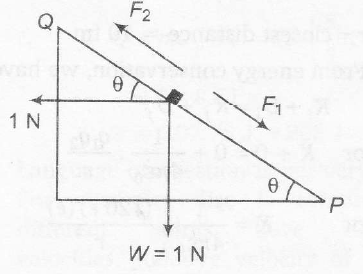Answer:
Option A,C
Explanation:
W=mg=0.1 x10=1N

$F_{1}= $ component of weight
=1$.\sin \theta= \sin \theta$
$F_{2}=$ component of applied force
=$1. \cos \theta= \cos \theta$
now, at $\theta= 45^{0}$ :$F_{1}=F_{2}$ and biock remains stationary without the help of friction.
For $\theta > 45^{0}$ ; $F_{2}>F_{1}$, so friction will act
towards Q.
For $\theta <45^{0}$ , $F_{2} >F_{1}$ ,
and friction will act towards P.